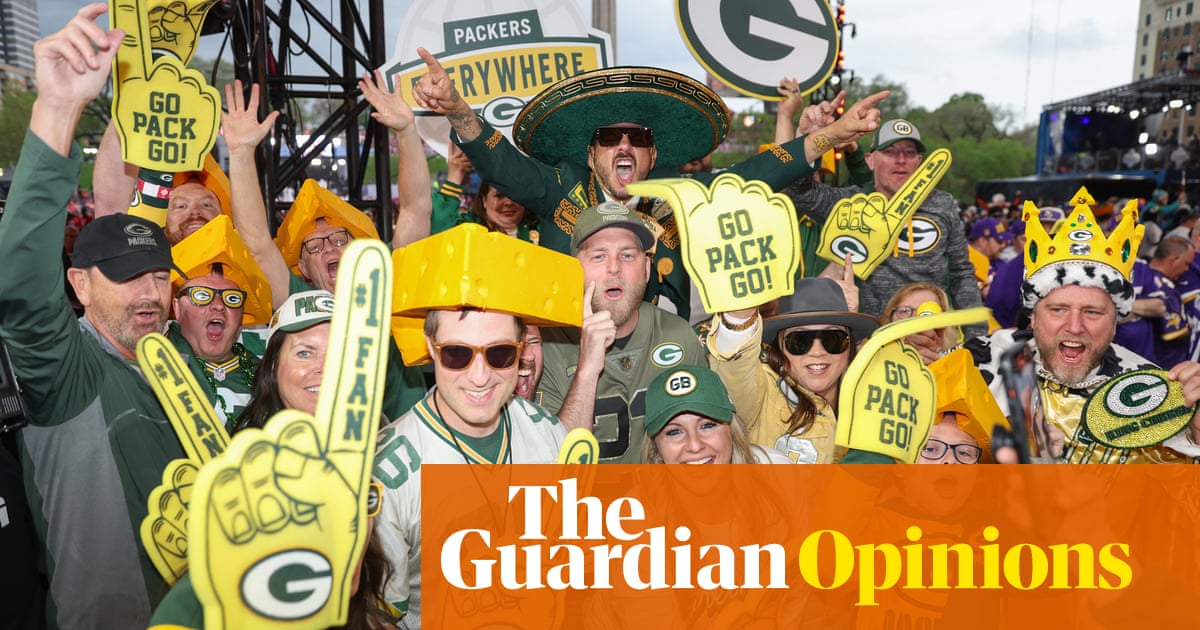I’ve just got back from a road trip in Wisconsin. The upper Midwest is not an obvious destination for a spring break, certainly not in early April. As my plane circled above Milwaukee, the brown and leafless landscape warned me I’d travelled back in time to midwinter.
It was too cold to brave the beaches – the Lake Michigan shore was covered in snow and ice – but the bars at least were convivial. This is often the case in Wisconsin, the state with the highest alcohol consumption per capita. Many of my fellow drinkers were keen to point out that they were responsible for nearly all the brandy sold in the US (as a collective, not individually).
Aside from the best recipe for an old fashioned, the main topic of conversation was the NFL draft, still nearly a month away. One particular stat dominated everybody’s consciousness: the quarter of million people expected to descend on Green Bay, which is hosting the event for the first time. In a tiny rural town at the other end of the state from the Packers’ home, I chit-chatted about the weather with an elderly jewellery store owner. “Oh, it can be yick yick,” she said. “But I guess it’s not stopping all these folks coming up to pick some sports teams or something.”
The upcoming draft was the perfect way to avoid dismay at the collapse of the global markets. From the wall-to-wall coverage on regional TV, you would have assumed that nothing was more important to the US economy right now than the price and availability of rooms in Ashwaubenon. The city of Green Bay’s young, bespectacled marketing director got more airtime than Katy Perry doing space.
It was an early Sunday morning, towards the end of my trip, when I finally made it to Lambeau Field. I’d eschewed the interstate and driven into town along the suburban streets that hug the eastern shore of the bay, which meant I could witness the continuous belch of the city’s industrial plants long before I reached them. I hadn’t really planned anything more than to park up outside the stadium and take a squint at it.
But a guy called Tim who was emptying the bins on the concourse told me that yes, there were tours on Sundays, and the doors would open in 10 minutes. Tim’s company had been responsible for the lighting at the ground before he retired; now he did a 16-hour week here to “keep him busy”. He was far from the only person I’d met on my trip with a post-retirement job. And those 401k pension plans were still plummeting.
At the ticket office I booked for the 90-minute “Champions” tour (longer than the “Classic”, shorter than the “Legendary”) and since everyone else was either at church or sleeping off a Saturday night out I got a private walk-round with both guides to myself. Before we headed field-side, Pat and Bob took me to a window to gaze on the operation beyond the parking lot, where cranes loomed above a half-built metal structure, and hard-hatted construction workers weaved about its stunted legs in buggies.
“That’s gonna be a huge main stage,” said Bob. Until 2014, the draft was held in a sequence of hotel conference rooms, and NYC’s Radio City Music Hall. Now, it’s a three-day outdoor festival accompanied by musical line-ups and kids camps. Almost 800,000 showed up to Detroit last year – many had travelled hundreds and even thousands of miles, ostensibly to watch big-screen broadcasts of telephones being answered and delighted rookies trying to suppress expletives in front of their parents.
But you don’t really come for the content. You come for the party, and the chance to say you were there, when your team snagged whoever. Green Bay can’t hope to host the Super Bowl itself: for a start, the average high in February is -2C. There’s a black-and-white photograph that hangs in a corridor at Lambeau Field of the famous “Ice Bowl” game that remains the coldest in NFL history. The deerstalker-wearing supporters stuck out three hours in conditions which, accounting for wind chill, reached -38C.
after newsletter promotion
Just as fatally, Green Bay can offer only a fraction of the hotel rooms the league requires of a host city. “So the draft is our Super Bowl,” said Bob. He still finds it amazing to imagine so many celebrities, team personnel and media flying into the tiny airport at Appleton. “Someone told me they expect 90 planes. I mean, where will these people think they are, on the drive over?”
Don’t ask me, I say. I’m a Brit whose sole exposure to franchise sport is an infant of a tournament called The Hundred. Its 2025 draft was reported from a chilly, echoey and all-but-empty media centre by a man called Charlie Dagnall, wearing a scarf and trying to convince livestream followers that this largely unnoticed allocation of playing staff was “two hours of absolute chaos”.
Perhaps it’s because my own fandom is acclimatised to the continual motion-sickness of promotion and relegation that I’ve never understood the obsession with the draft. What’s the appeal? Pat’s answer comes instantly. “It’s a fresh beginning,” he said. “Everybody hopes that they’re finally going to get the best players, the players that are going to take their team to the Super Bowl. It’s about hope.” Ah, hope, that rare earth element, more precious in these times even than Silicon Valley shares.
But also, says Pat, it’s about the tailgating parties. His friends in the booze business here in town tell him the wholesalers have been sending stock up by railcar for weeks. Well, I say, I guess everyone could use a good time right now. “Did you know,” asked Bob, “that 85% of all the brandy in the United States is consumed in Wisconsin?”
